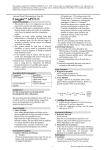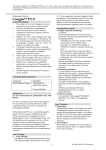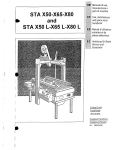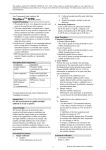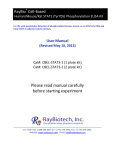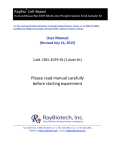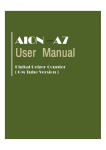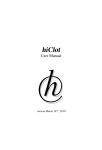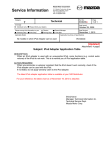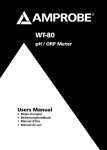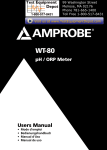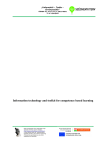Download Coagpia™ Fbg
Transcript
This product marketed by SEKISUI MEDICAL CO., LTD., Tokyo, Japan is manufactured subject to our supervision as stipulated in the Pharmaceutical Affairs Law of Japan and is allowed to be sold in Japan. For details, please contact us or your local distributors. plasma sample, the time taken for fibrin to form from blood fibrinogen (coagulation time: sec) is measured. Since coagulation time is dependent on the fibrinogen concentration in the test sample, fibrinogen concentration (mg/dL) is determined by using a calibration curve prepared from plasma containing known fibrinogen concentrations. Fibrinogen Assay Kit Coagpia™ Fbg General Precautions 1. This product is for in vitro diagnostic use only, and must not be used for any other purposes. 2. Clinicians should make a comprehensive clinical decision based on assay results in conjunction with clinical symptoms and other examination results. 3. Influence on assay values resulting from drug administration is described in Precautions for Use in the package insert for the relevant drugs. In particular, carefully read the section on influence on clinical test results. 4. This product should be used only as directed. Reliability of values cannot be guaranteed if this product is used for purposes or tested by methods other than those stated. 5. Thrombin reagent contains ingredients derived from human blood tested negative for HIV-antibody, HCV-antibody and HBsAg. However, please handle this product as if potentially infectious. 6. If the reagents come in contact with the eyes or mouth, rinse thoroughly with water as first aid, and seek medical treatment if necessary. 7. Read the user’s manual of your automated analyzer prior to using this kit. Parameters for different automated analysers are available upon request. 8. Perform a quality control test prior to assay to ensure accuracy. Description (Kit Components) Component Ingredients Sample Dilution HEPES Buffer Solution Solution Thrombin Reagent Thrombin Procedural Precautions 1. Sample Collection and Storage 1) Samples Plasma (citrated plasma) can be used. Do not use plasma containing anticoagulants other than sodium citrate. 2) Sample Preparation Promptly mix nine parts of blood sample with one part of 3.2% sodium citrate. Centrifuge in a refrigerated centrifuge at 1500G for 15 minutes to separate plasma.2) Transfer the plasma into a separate plastic test tube and refrigerate or store on ice. 3) Sample Storage i) Start the assay promptly after blood collection. If the sample has been stored at 2-10°C, perform assay within 3 days, and if it has been stored at -28°C or below, perform assay within 4 days.4) Bring samples to room temperature (15-30C) before use. ii) To prevent denaturing of fibrinogen, thaw frozen samples quickly at 37°C. Avoid repeated freezing and thawing, which can produce inaccurate results. 2. Interfering Substances 1) Assay results will not be affected by free bilirubin (up to 25 mg/dL), conjugate bilirubin (up to 25 mg/dL), hemoglobin (up to 500 mg/dL), formazin turbidity (up to 3000 units), intralipose (up to 4%) and heparin sodium (up to 8 U/mL). 3. Other Precautions 1) Use Calibrator for Coagpia™ (SEKISUI MEDICAL CO., LTD.) as the calibration material. 2) When the concentration of a sample exceeds the measurement range, dilute the plasma 20 fold with sample dilution solution and repeat the measurement. 3) Other dilution solutions can be used in place of the sample dilution solution. Please contact SEKISUI MEDICAL CO., LTD. for information. Intended Use For the measurement of fibrinogen in plasma Fibrinogen is an acute phase reactive protein that is synthesized by hepatic parenchymal cells. Fibrinogen plasma concentrations increase due to infectious diseases, malignant tumours and thrombotic diseases in the acute phase and decrease due to hepatic parenchymal lesions (due to decreased production), disseminated intravascular coagulation (DIC) syndrome (due to progressive fibrinogen consumption) and other conditions.1) Fibrinogen measurements are used to understand the pathological condition and to supplement the diagnosis of these diseases. Assay Procedure 1. Preparation 1) Sample Dilution Solution: Ready-to-use 2) Thrombin Reagent: Ready-to-use 2. Assay Method This product is compatible with various types of automated analyzers. Below is a general example of the assay procedure. Assay Principle 1. Assay Principle Coagpia™ Fbg is a reagent that determines fibrinogen concentrations in plasma based on the principle of the thrombin time method. After a certain amount of thrombin is added to a diluted 1 Revised: (Jan) 2009 (5th edition) This product marketed by SEKISUI MEDICAL CO., LTD., Tokyo, Japan is manufactured subject to our supervision as stipulated in the Pharmaceutical Affairs Law of Japan and is allowed to be sold in Japan. For details, please contact us or your local distributors. (Preparation of Samples) Plasma sample 10 L Sample dilution 37°C solution + 90 L 6. Sample 100 L Reference Method: Coagulation time method (MHLW approved IVD) Standard Calibration Material NIBSC standard material (98/612) Precautions and Warnings 1. Handling Precautions (Measurement of Coagulation Time) 1) All samples used in the test should be handled as if potentially infectious for HIV, HBV and Thrombin Sample 37°C Measure HCV. To prevent infection, use disposable reagent 100 L + Coagulation time gloves and avoid mouth pipetting during the 50 L test. Calibration material: Calibrator for Coagpia™ (value 2) ProClin300, which possesses skin-irritative assigned by SEKISUI MEDICAL CO., LTD.) potential, has been added as an antiseptic agent 3. Calculation of Fibrinogen Concentration in both the sample dilution solution and the (mg/dL) thrombin reagent. Therefore, if the reagents 1) Use sample dilution solution to perform 5, 10 come in contact with skin or clothes, rinse and 20 fold dilutions of Coagpia™ calibrator. immediately with water, and consult a doctor if 2) Add thrombin reagent to each of the above skin irritation develops. diluted specimens and measure coagulation 2. Precautions for Use time. 1) This product should be stored as directed. 3) Plot fibrinogen concentrations (mg/dL) on the Avoid freezing. Freezing can cause x-axis and coagulation times on the y-axis to deterioration of the reagents, which can prepare a calibration curve. 5, 10 and 20-fold produce inaccurate results. diluted fibrinogen concentration values are 2) Do not use expired reagents. Reliable assay double, equal to, and half the indicated values, values cannot be obtained if expired reagents respectively. are used. 4) Dilute the plasma sample 10 times with sample 3) Do not replenish the reagents. dilution solution. Calculate the concentration of 4) Do not perform the assay under direct sunlight. fibrinogen (mg/dL) using a pre-prepared 3. Precautions for Disposal calibration curve based on the coagulation time 1) Before disposal, used samples and containers measurements that were performed after must be soaked in sodium hypochlorite solution thrombin reagent was added. of concentration greater than 0.1% for more Some measuring instruments (blood coagulation than an hour or autoclaved at 121C for 20 analyzers) may automatically carry out steps 1) - 4) minutes. to calculate the fibrinogen concentration (mg/dL). 2) To prevent infections from spilled samples or 4. Precautions for Use sample-contained solutions, wipe the spill area After completing the assay, seal the bottle and thoroughly with sodium hypochlorite solutions store at 2-10°C. at concentration of greater than 0.1%. 3) The reagents and samples should be disposed as Assessment of Results 3) medical waste or industrial waste in accordance 1. Reference Interval with waste disposal regulations. 200-400 mg/dL 4) The reagents should be disposed in consideration of water pollution control Performance regulations or related regulations. 1. Sensitivity 4. Other Precautions Coagulation Time: Do not use the containers for any other purposes. Normal plasma diluted 10 fold per fibrinogen 300 mg/dL: 7-13 seconds Storage and Shelf Life Normal plasma diluted 20 fold per fibrinogen 1. Storage temperature: 2-10C 150 mg/dL: 15-24 seconds 2. Shelf life: 2 years from the date of manufacture 2. Accuracy (The expiration date is printed on the outside of 80-120% of the expected assay value the package.) 3. Within-run Reproducibility Coefficient of variation 10% (Test methods used for 1.-3. are in-house methods.) 4. Measurement Range (on Coaglex 800 blood coagulation analyzer)4) 40-800 mg/dL 5. Correlation4) N = 87, r = 0.990, y = 1.03x + 0.68 2 Revised: (Jan) 2009 (5th edition) This product marketed by SEKISUI MEDICAL CO., LTD., Tokyo, Japan is manufactured subject to our supervision as stipulated in the Pharmaceutical Affairs Law of Japan and is allowed to be sold in Japan. For details, please contact us or your local distributors. Package Contents Description Coagpia™ Fbg Configuration Sample Dilution Solution Thrombin Reagent 10 mL x 10 3 mL x 10 . References 1) The Japanese Society for Laboratory Hematology: Standard Laboratory Hematology, p136-139 Ishiyaku Pub, Inc. (2003) 2) The Japanese Society for Laboratory Hematology: Standard Laboratory Hematology, p75-78 Ishiyaku Pub, Inc. (2003) 3) Kanai, Masamitsu: Clinical examination method summary, p 419, Kanehara Co., Ltd. (2005) 4) SEKISUI MEDICAL CO., LTD. In-house data Marketing Authorization Holder SEKISUI MEDICAL CO.,LTD. 13-5, Nihonbashi 3-chome, Chuo-ku, Tokyo, Japan [email protected] "Coagpia" is a trademark owned by SEKISUI MEDICAL CO.,LTD. JAPAN, and is registered in Japan and/or other countries. 3 Revised: (Jan) 2009 (5th edition)



